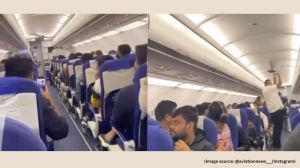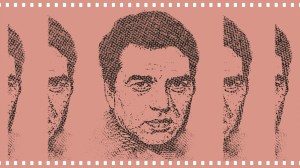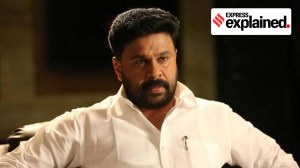Amid three-language war, data shows only one-fourth Indians are multilingual
As per 2011 Census, while 43.63% of Indians say Hindi is their mother tongue, it is spoken by less than 5% of population in 12 states and UTs, including Tamil Nadu, Kerala, Andhra Pradesh and Karnataka.
 Tamil Nadu Chief Minister M K Stalin said Tamils would not accept such a “blackmail”, asking “which constitutional provision” made the three-language formula mandatory. (X/MK Stalin)
Tamil Nadu Chief Minister M K Stalin said Tamils would not accept such a “blackmail”, asking “which constitutional provision” made the three-language formula mandatory. (X/MK Stalin)In 1968, a national education policy (NEP) formulated by the Indira Gandhi-led Congress government had introduced the three-language formula. Centred on a Hindi-English fulcrum, the policy called for teaching a southern language in Hindi-speaking states and a regional language in non-Hindi-speaking states as the third language.
Since then the three-language formula has been an issue of intense dispute. In 1968, Tamil Nadu had opposed the policy and has since persisted with a two-language formula of its own.
Currently, the DMK-led Tamil Nadu government is at loggerheads with the BJP-ruled Centre over its NEP 2020, which has retained the three-language formula with fewer restrictions on the choices of languages.
The recent row between Tamil Nadu and the Centre erupted after Union Education Minister Dharmendra Pradhan indicated that the former would not be provided funds under the Samagra Shiksha programme for school education until it implements the NEP and adopts its three-language rule.
In response, Tamil Nadu Chief Minister M K Stalin said Tamils would not accept such a “blackmail”, asking “which constitutional provision” made the three-language formula mandatory. The DMK has alleged that this formula was merely a guise for “Hindi imposition”.
In the Congress-led Telangana government’s push against the NEP, Telugu was on Tuesday made a compulsory language across all school boards.
The Centre has, however, maintained that no specific language would be imposed on any state.
In 1968 and 2020, the stated objective of the three-language formula was to promote multilingualism. However, data from the 2011 Census shows that despite India’s language diversity, over half a state’s population speaks more than two languages in just eight states and UTs.
Nationally, 26.02% of the population is bilingual and 7.1% is trilingual, as per the 2011 Census. While the bilingual population has grown from 24.79% in the 2001 Census, the share of trilingual speakers fell from 8.51%.
Between 2001 and 2011, bilingualism fell in 12 states and UTs, while trilingualism fell in 23 states and UTs.
Tamil Nadu, despite sticking to its two-language formula, ranked 15th in 2011 for its share of bilingual population at 28.3%. At 3.39%, its trilingual population put the state at eighth from the bottom.
However, five lowest-ranked states on bilingualism are Rajasthan (10.9%), Uttar Pradesh (11.45%), Bihar (12.82%), Chhattisgarh (13.25%), and Madhya Pradesh (13.51%). These states, which fall in the Hindi heartland, are also in the bottom five for trilingualism, with each falling below 2%.
 MAP: Bilingualism by state, 2011 Census
MAP: Bilingualism by state, 2011 Census
The best performing state on multilingualism is Goa – 77.21% of its population is bilingual and 50.82% is trilingual. Goa is the only state where trilingualism exceeds 50%, followed by Chandigarh with 30.51% and Arunachal Pradesh with 30.25%.
The other states and UTs with high rates of bilingualism are Andaman & Nicobar Islands (67.64%), Arunachal Pradesh (64.03%), Sikkim (63.71%), Nagaland (62.15%), Chandigarh (54.95%), Manipur (54.02%), and Maharashtra (51.1%).
 MAP: Trilingualism by state, 2011 Census
MAP: Trilingualism by state, 2011 Census
The 2011 Census also shows that eight of the 10 most common language combinations for bilinguals include Hindi. With 3.47 crore speakers, Marathi-Hindi is the most common bilingual combination, followed by Hindi-English at 3.2 crore, Gujarati-Hindi at 2.17 crore, Urdu-Hindi at 1.86 crore, and Punjabi-Hindi at 1.55 crore. Tamil-English at 1.23 crore and Telugu-English at 80.75 lakh are the only two combinations in the top 10 that do not include Hindi.
In 2001 though, Hindi-English was the most common bilingual combination at 3.24 crore, followed by Marathi-Hindi at 2.59 crore, Gujarati-Hindi at 1.49 crore, Urdu-Hindi at 1.31 crore, and Punjabi-Hindi at 1.22 crore. That year, Bengali-English at 92.42 lakh was the most spoken bilingual combination that did not contain Hindi. In fact, five of the 10 most common combinations for bilinguals did not contain Hindi in 2001.
In 2011, among trilinguals, Marathi-Hindi-English is the most common combination at 1.01 crore, followed by Punjabi-Hindi-English at 77.99 lakh, Gujarati-Hindi-English at 66.32 lakh, Telugu-English-Hindi at 25.04 lakh, and Malayalam-English-Hindi at 24.76 lakh. Each of the 10 most common trilingual combinations contains Hindi and English. The most spoken trilingual combination that does not include Hindi is Kashmiri-Urdu-English at 64.79 lakh, while the most common combination excluding both Hindi and English is Telugu-Kannada-Tamil at 1.6 lakh.
In 2001, too, many of the most common trilingual combinations of 2011 had featured in the top 10. Marathi-Hindi-English at 84.91 lakh was the most spoken combination, followed by Punjabi-Hindi-English at 65.92 lakh, Gujarati-Hindi-English at 48.43 lakh, Malayalam-English-Hindi at 39.16 lakh, and Telugu-English-Hindi at 39.04 lakh.
While the 2011 Census reported that 43.63% of Indians say Hindi is their mother tongue, it is spoken by less than 1% of population in five states and UTs, including Tamil Nadu and Kerala, and by less than 5% of population in another seven states and UTs, including Andhra Pradesh and Karnataka. Andhra, which included Telangana in the 2011 Census, had the highest proportion of Hindi speakers among the southern states at 3.69%.
UP row over Urdu
In Uttar Pradesh, the Opposition Samajwadi Party (SP) recently protested over the inclusion of English and omission of Urdu among the languages for translation of the Assembly proceedings. Four regional languages – Awadhi, Bhojpuri, Braj and Bundeli – were also included for translation of the House proceedings. The SP sought the inclusion of Sanskrit too.
While the SP argued that its leaders had “fought a long battle against the imposition of English”, Chief Minister Yogi Adityanath slammed the party, alleging that its leaders send their own children to English-medium schools but want others’ children to learn Urdu and become “maulvis (Islamic clerics)”.
As per the 2011 Census, while Hindi is the most spoken language in UP with 18.8 crore or 94% of the population calling it their mother tongue, Urdu is the second-most spoken language at 1.08 crore or 5.42%. Across the country, UP has the sixth highest proportion of Urdu speakers — the highest being in Karnataka with 10.83%.
In contrast, English has been listed as their mother tongue by just 13,085 people in UP as per the 2011 Census.
All four regional languages included for translation in the UP Assembly are dialects of Hindi. The speakers of Bhojpuri, Awadhi, Braj and Bundeli in UP are, respectively, 2.18 crore, 38.02 lakh, 7.14 lakh, and 13.04 lakh. Just 3,062 people in UP reported Sanskrit as their mother tongue.
- 01
- 02
- 03
- 04
- 05































